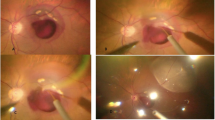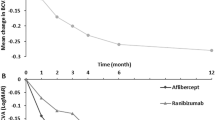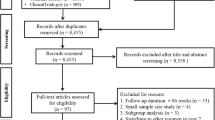Abstract
Purpose:
To evaluate frequency of injections, visual and anatomical outcomes of neovascular age-related macular degeneration (nAMD) patients transitioned to intravitreal aflibercept after failure to extend treatment interval beyond 8 weeks with prior intravitreal bevacizumab or ranibizumab.
Methods:
Retrospective review of patients with nAMD switched to aflibercept following ≥6 prior intravitreal ranibizumab or bevacizumab injections at 4–8-week intervals. Three monthly aflibercept injections were given followed by a treat-and-extend dosing regimen.
Results:
Twenty-one eyes of 18 patients who had received a mean of 23.8±18.8 (mean±SD; range 6–62) prior ranibizumab or bevacizumab injections were included. Over a mean follow-up of 24 months after the transition, 9.2±2.9 (range 4–21) aflibercept injections were required. Interval between aflibercept injections increased to 57.3 days (range 35–133 days), as compared with 37±6.1 days (range 29–54 days) with the prior agents (P=0.01). Mean best-corrected visual acuity was preserved (0.42±0.31 vs 0.42±0.23 logMAR; P=0.2). Mean OCT central subfoveal thickness (292.1±83.2 μm to 283.6±78.6 μm; P=0.4) and mean macular volume (7.9±0.95 mm3 to 7.67±0.94 mm3; P=0.16) remained stable.
Conclusion:
Patients requiring treatment more frequently than every 8 weeks with ranibizumab and bevacizumab were transitioned to >8-week treatment interval with aflibercept while maintaining the anatomic and visual gains.
Similar content being viewed by others
Log in or create a free account to read this content
Gain free access to this article, as well as selected content from this journal and more on nature.com
or
References
Gupta OP, Shienbaum G, Patel AH, Fecarotta C, Kaiser RS, Regillo CD . A treat and extend regimen using ranibizumab for neovascular age-related macular degeneration clinical and economic impact. Ophthalmology 2010; 117: 2134–2140.
Shienbaum G, Gupta OP, Fecarotta C, Patel AH, Kaiser RS, Regillo CD . Bevacizumab for neovascular age-related macular degeneration using a treat-and-extend regimen: clinical and economic impact. Am J Ophthalmol 2012; 153: 468–473.
Heier JS, Brown DM, Chong V, Korobelnik JF, Kaiser PK, Nguyen QD et al. Intravitreal aflibercept (VEGF trap-eye) in wet age-related macular degeneration. Ophthalmology 2012; 119: 2537–2548.
Chang AA, Li H, Broadhead GK, Hong T, Schlub TE, Wijeyakumar W et al. Intravitreal aflibercept for treatment-resistant neovascular age-related macular degeneration. Ophthalmology 2014; 121: 188–192.
Wykoff CC, Brown DM, Maldonado ME, Croft DE . Aflibercept treatment for patients with exudative age-related macular degeneration who were incomplete responders to multiple ranibizumab injections (TURF trial). Br J Ophthalmol 2014; 98: 951–955.
Grewal DS, Gill MK, Sarezky D, Lyon AT, Mirza RG . Visual and anatomical outcomes following intravitreal aflibercept in eyes with recalcitrant neovascular age-related macular degeneration: 12-month results. Eye (Lond) 2014; 28: 895–899.
Kumar N, Marsiglia M, Mrejen S, Fung AT, Slakter J, Sorenson J et al. Visual and anatomical outcomes of intravitreal aflibercept in eyes with persistent subfoveal fluid despite previous treatments with ranibizumab in patients with neovascular age-related macular degeneration. Retina 2013; 33: 1605–1612.
Messenger WB, Campbell JP, Faridi A, Shippey L, Bailey ST, Lauer AK et al. Injection frequency and anatomic outcomes 1 year following conversion to aflibercept in patients with neovascular age-related macular degeneration. Br J Ophthalmol 2014; 98: 1205–1207.
Acknowledgements
This work was supported in part by a unrestricted grant from Research to Prevent Blindness, NY.
Author information
Authors and Affiliations
Corresponding author
Ethics declarations
Competing interests
The authors declare no conflict of interest.
Additional information
Meeting Presentation: Presented in part as a poster at the Association for Research in Vision and Ophthalmology Annual Meeting in May 2014
Rights and permissions
About this article
Cite this article
Homer, N., Grewal, D., Mirza, R. et al. Transitioning to intravitreal aflibercept following a previous treat-and-extend dosing regimen in neovascular age-related macular degeneration: 24-month results. Eye 29, 1152–1155 (2015). https://doi.org/10.1038/eye.2015.87
Received:
Accepted:
Published:
Issue date:
DOI: https://doi.org/10.1038/eye.2015.87
This article is cited by
-
How Successful is Switching from Bevacizumab or Ranibizumab to Aflibercept in Age-Related Macular Degeneration? A Systematic Overview
Advances in Therapy (2019)
-
Clinical outcomes of switching to aflibercept using a pro re nata treatment regimen in patients with neovascular age-related macular degeneration who incompletely responded to ranibizumab
BMC Ophthalmology (2018)
-
Switch to aflibercept or ranibizumab after initial treatment with bevacizumab in eyes with neovascular AMD
BMC Ophthalmology (2017)
-
Aflibercept as a Second Line Therapy for Neovascular Age Related Macular Degeneration in Israel (ASLI) study
Eye (2017)
-
Comment on ‘Transitioning to intravitreal aflibercept following a previous treat-and-extend dosing regimen in neovascular age-related macular degeneration: 24-month results’
Eye (2015)



